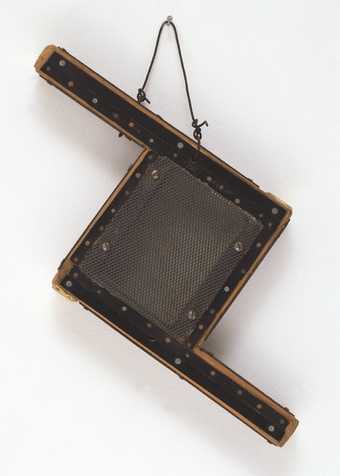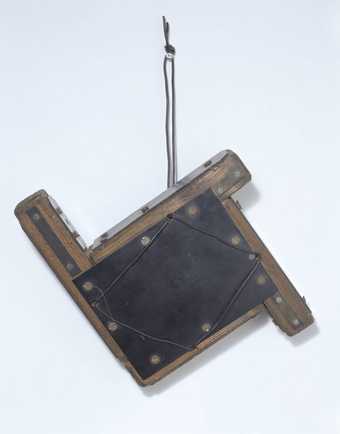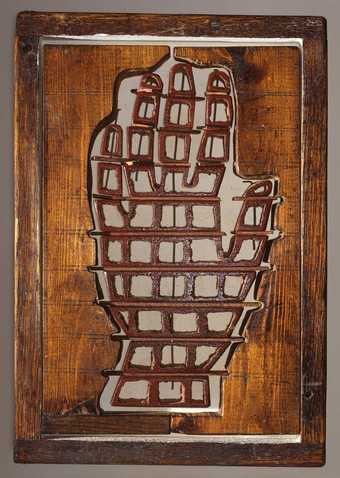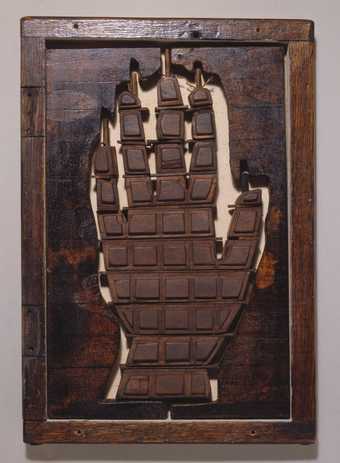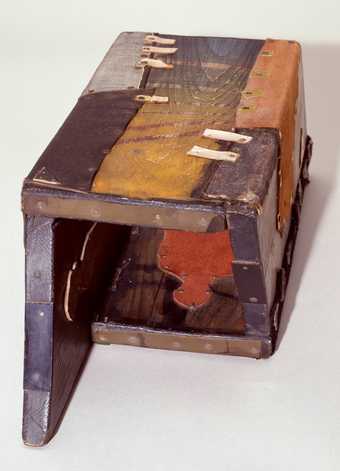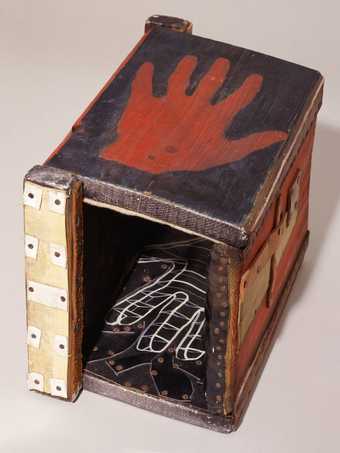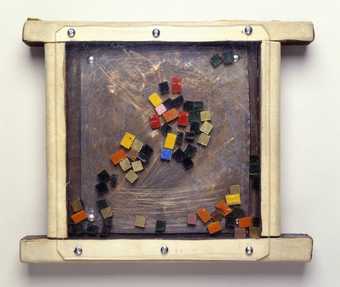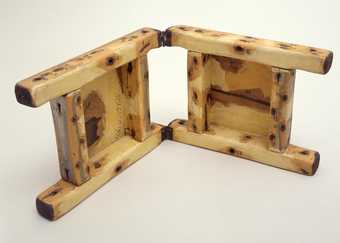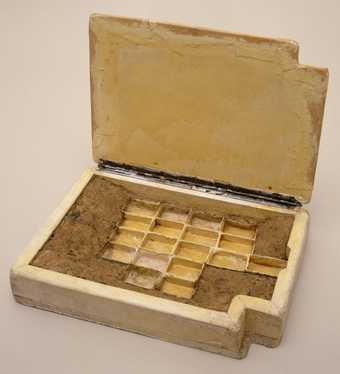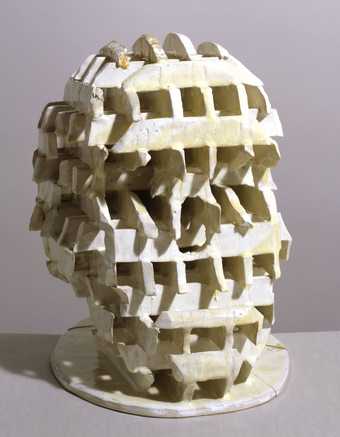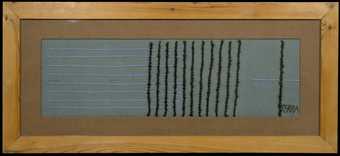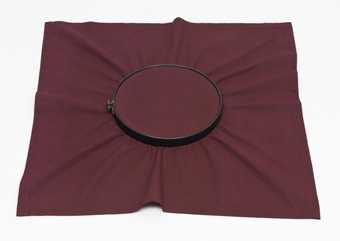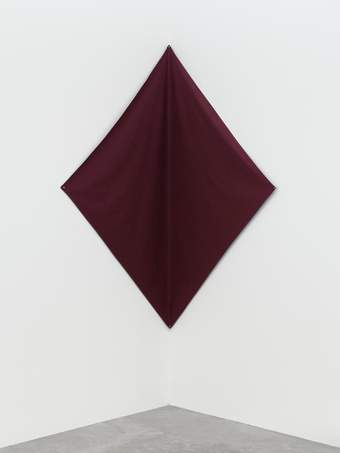
In Tate Modern
- Artist
- Geta Bratescu 1926 – 2018
- Medium
- 6 panels, cotton thread embroidered on linen on felt
- Dimensions
- Object, each: 757 × 614 × 49 mm
- Collection
- Tate
- Acquisition
- Purchased with funds provided by the Russia and Eastern Europe Acquisitions Committee 2014
- Reference
- T14032
Summary
Medeic Callisthetic Moves 1980–1 is a set of six embroideries on bleached linen; each one is 600 by 500 millimetres. They are always shown as a group in an order specified by the artist, who refers to them as ‘drawings’. Originally, the works were displayed attached directly to the wall, but they are now glazed. The pastel coloured pattern on each one was done with the use of a sewing machine. An abstract oval form is repeated in the centre of each of the embroideries and is an emblematic portrait of the Greek mythical character Medea, who gives the work its title. Medea was the daughter of King Aeetes of Colchis and the granddaughter of the sun god Helios. Known for her qualities as a sorceress, Medea helped the adventurer Jason obtain the golden fleece from her father, killing her own brother as she aided Jason and his Argonauts to flee. Although he had promised to marry her, Jason later deserted her.
One of Romania’s foremost contemporary artists, Bratescu often works in series, exploring in depth chosen topics for extensive periods of time. Her interest in the culture of the Mediterranean forms an important point of reference for her practice, in which Greek and Balkan mythology is a recurring motif. Medeic Callisthetic Moves was finished in the last year of Bratescu’s preoccupation with the story of Medea which inspired a major series of works. This started in 1978 and encompasses a cycle of drawings (Medea – Her Six Working Days 1978), followed by a set of lithographs (Medea – Ten Portraits of Her 1979) and further textile works titled Hypostases of Medea 1980. They were initially exhibited under the common generic name Medeic Forms. Each work resulted from the previous one and Medeic Callisthetic Moves is the culmination of the cycle. The artist explained:
I had drawn an island landscape with a tree from above – a lithograph project. I held up the drawing to look at it – the drawing turned into a profile ... I chose the portrait-side and repeated it in new variants.
The lithographs resumed the drawings in a more wanton state of mind, as I was experimenting with the synchronizing of the four colours, which had to be devised on different plates. I then figured that this profile pattern would lend itself to a larger scale and a more objectual technique. I stumbled upon the difficulty of thinking the motif in new terms. The first four faces only were trouble – the rest got themselves structured in their track. That is why the order they are shown in should preserve their original order. The drawings on bleached linen are in a way a comment to the series of TEN HYPOSTASES, just as the lithographs are to the six drawings.
(Quoted in National Museum of Art of Romania, p.157 [translation slightly edited].)
The artist describes her medium in this work as ‘drawing on textile with sewing machine’. This description sheds light on a crucial aspect of Bratescu’s working process, drawing being at the core of everything she does even when working across a range of media including performance, film, drawings, graphic work, collage, photography and textiles. A large part of her practice consists of precise academic studies and sketches, as well as visual instructions and written notes. However, the choice of technique and material for Medeic Callisthetic Moves links the work with a rich classical symbolism of thread and weaving. The series devoted to Medea relates closely to cultural constructs around womanhood and the roles and activities traditionally ascribed to women. The mythical character of Medea is an embodiment of the sometimes tragic results of the tensions that arise between social conventions and expectations and personal emotions and desires. The Romanian philosopher and art critic Andrei Plesu, in an essay titled Medea and the Paradox of Womanhood which accompanied the exhibition Portraits of Medea at Simeza Gallery, Bucharest in 1981, commented:
Weaving is a test particular to all initiations to the mysteries of womanhood. It is the most characteristic work of women – selenial and nocturnal labour opposite to men’s solar, daytime jobs. Symbolically, weaving is always accompanied by its reverse: unraveling. Thus, its industrious urge remains ambiguous like Penelope who would destroy at night her long day’s work. Medea is nothing but Penelope’s nocturnal hypostasis, the symbol of unraveling par excellence. Medea is an exasperated Penelope who creates the nightmare of home, instead of its beatitude.
(In National Museum of Art of Romania, p.158.)
Medeic Callisthetic Moves was one of a group of works by Bratescu included in the exhibition The Encyclopedic Palace at the Venice Biennale in 2013.
Further reading
Ruxandra Balaci (ed.), Geta Bratescu, exhibition catalogue, National Museum of Art of Romania, Bucharest 1999.
Magda Radu, Geta Bratescu. The Artist’s Studios, Salonul de projecte, Bucharest 2012.
Geta Bratescu, ‘My Influences’, Frieze, no.150, October 2012, pp.190–5.
Kasia Redzisz
September 2013
Does this text contain inaccurate information or language that you feel we should improve or change? We would like to hear from you.
Explore
- abstraction(8,615)
-
- non-representational(6,161)
-
- irregular forms(2,007)
- formal qualities(12,454)
-
- diagrammatic(799)
- gestural(763)
- texture(466)
You might like
-
Paul Neagu Tactile Object 2
1969 -
Paul Neagu Great Tactile Table
1970 -
Paul Neagu Tactile Object 3
1970 -
Paul Neagu Empty Hand
1970–1 -
Paul Neagu Full Hand
1970–1 -
Paul Neagu Palpable Object
1970–2 -
Paul Neagu Tactile Object (Hand)
1970 -
Paul Neagu Palpable Object (Mosaic)
1970 -
Paul Neagu (White) Tactile Object with Hinges
1969 -
Paul Neagu Box, Tactile Object (Receptacle)
1972 -
Paul Neagu Ceramic Skull
1973 -
Ian Hamilton Finlay Terra/Mare (Collaboration with Pamela Campion)
1973 -
Reiner Ruthenbeck Red Cloth with Stretcher
1973 -
Reiner Ruthenbeck Corner Cloth
1974, 1975 -
Unknown woman artist, Chile [no title]
1970s

